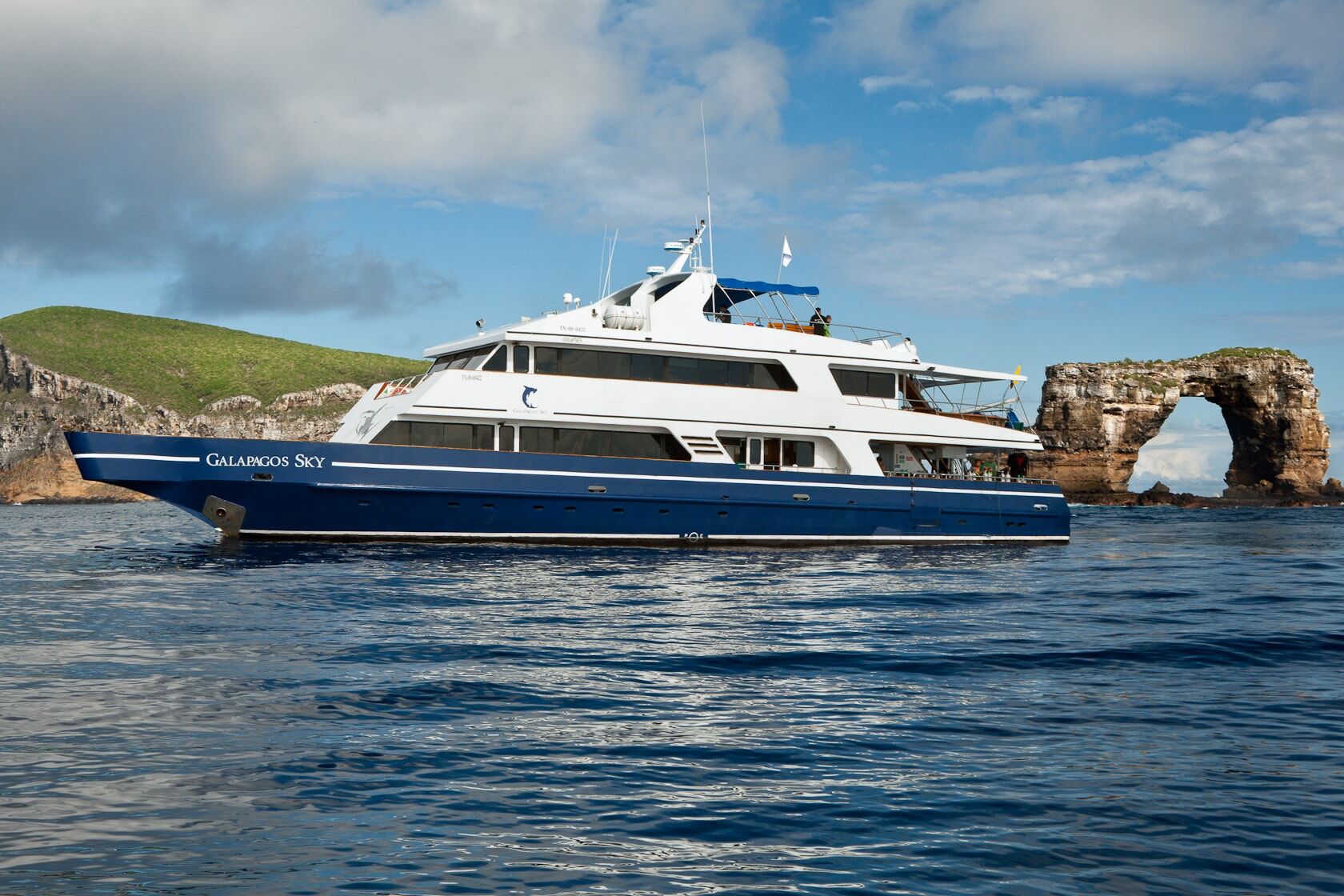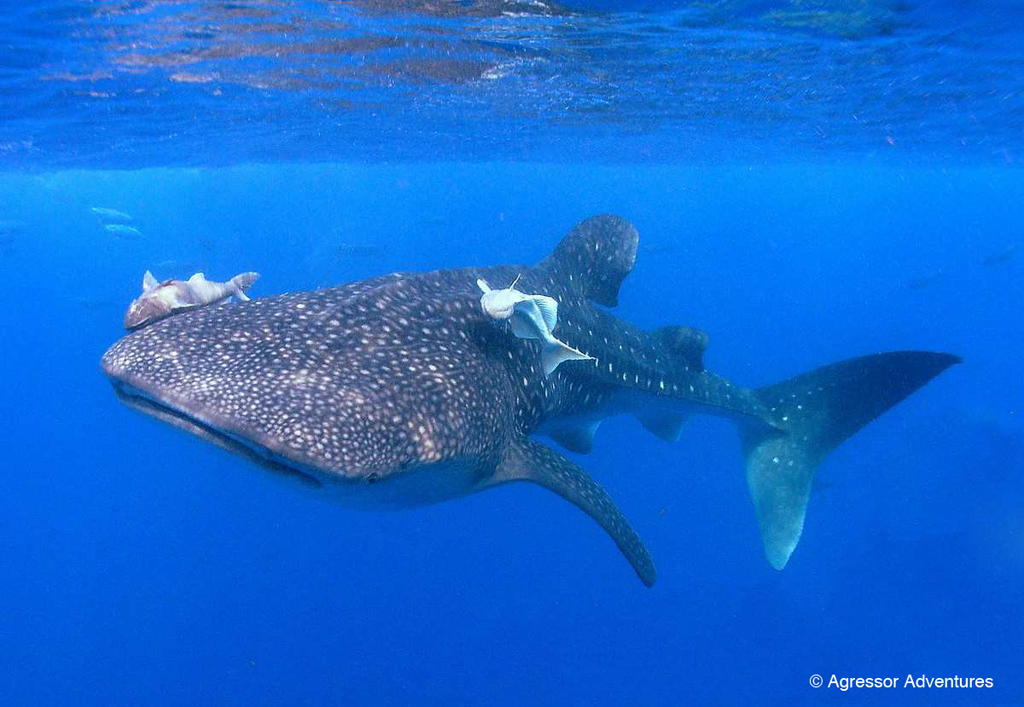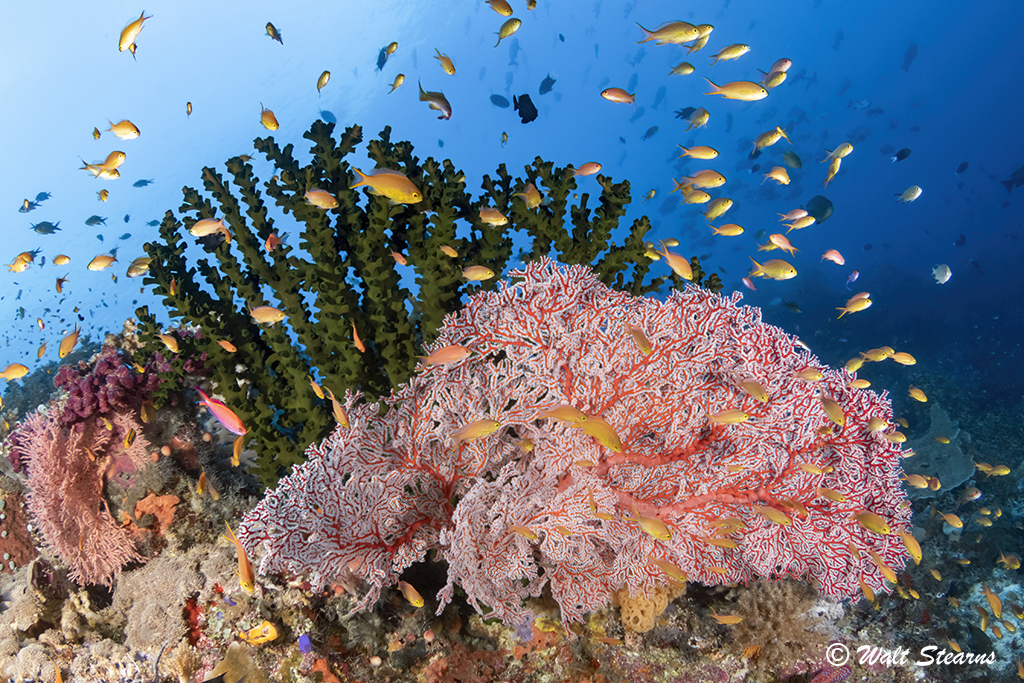
Most dive trips begin with a boat ride. But when the schedule calls for returning to the docks by lunchtime — or happy hour — that sets a limit on the sites that can be visited. Some of the world's best underwater experiences lie beyond the range of day boats. And that's where liveaboards come in. These mobile dive resorts are able to venture long distances from port, giving divers unequaled access to some of the most storied underwater landscapes on earth. Here are seven world-class dive destinations that can only be reached by liveaboard.
Wolf and Darwin Islands
The Galapagos Islands are famous for unique and abundant marine life. But to get in on the best big animal action, you'll want to book a liveaboard that travels 100 miles northwest from the main island group to uninhabited Wolf and Darwin islands. These otherwise uninviting rock spires sit at the convergence of oceanic currents that nurture a rich underwater ecosystem and provide water temperatures a few degrees warmer than around the southern islands. And where there's food, the big fish gather.

What's there to see? For starters, there are sharks. In all, there are more than 30 species of sharks that have been encountered in the Galapagos. Among the more common are the Galapagos sharks that show up by the dozen. Silky sharks cruising solo or patrol with a pack, while white tips and black tips forage among the rocky slopes. Tiger sharks visit during the warmer months, and massive schools of hammerheads make seasonal appearances. And then there's the biggest shark of all. The Galapagos are known for sightings of large whale sharks, which can reach lengths of 45 feet in these waters. Of course, sharks aren't the only draw at Darwin and Wolf. The waters are filled with swirling masses of bigeye jacks and schools of skipjack and yellowfin tuna. Bottlenose dolphins come to play, turtles are a given and there a good chance of seeing eagle and manta rays.
Tubbataha
The islands of the Philippines reward divers with thousands of miles of coral reef. Some of the most pristine and treasured coral ecosystems are found in the waters of Tubbataha Reefs Natural Park. Accessing this seldom-visited marine reserve requires a 12-hour boat ride, and that means liveaboard. Once there, divers have an exciting range of adventures to enjoy. There's the current-washed site known as the Washing Machine, where whitetip, blacktip, and grey reef sharks gather by the dozens. The cleaning station known as Shark Airport attracts even more big animals, including silky sharks, rays and whale sharks.

Walls and outcroppings rising from open water attract swirling schools of jacks, rainbow runners, mackerel and tuna, while schooling hammerhead sharks come in from the blue. Turning attention to the lush coral growth will yield smaller treasures such as colorful crinoids and insanely patterned nudibranchs. And then there are the wrecks, one sitting on the edge of the abyss, another that hosts a busy cleaning station where their patronage may include tiger sharks. In all, Tubbataha is home to more than 570 species of fish, 370 species of corals, 11 species of sharks, 12 species of dolphins and whales, plus hawksbill and green sea turtles. A pretty good reward for a boat ride.
Socorro Islands
Whether you call it the Revillagigedo Archipelago or the Socorro Islands, it's just different names for the same incredible underwater experience. This collection of uninhabited rock islands – Socorro, Clarion, San Benedicto and Roca Partida – lie some 240 miles southwest of Cabo San Lucas. Don't expect pretty corals, as the underwater landscape of these volcanic spires are stark slopes, ridges and offshore pinnacles. The reason to make the long boat ride isn't the scenery, it's what swims in from blue water.

The Socorro Island are a hot spot for big animal encounters, and particularly known for manta rays. There's a good chance of seeing manta rays on any dive, and they are an almost sure thing at San Benedicto island, where there is a cleaning station that holds the big rays. Mantas aren't the only big attraction in the Socorros. Divers can expect dolphin pods, schooling jacks and yellowfin tuna, humpbacks, false killers and pilot whales, along with plenty of sharks, including Galapagos, silky, oceanic whitetip and hammerheads.
Ribbon Reefs
Australia's Great Barrier Reef is one of the true natural wonders of the world. Divers come from around the world to experience the planet's largest coral reef, and the vast majority start their trip from the port of Cairns. To escape the crowds, divers in the know book a liveaboard trip to the Ribbon Reefs. This series of wall-like coral ramparts begin some 60 miles north of Cairns, and run parallel to the coast for another 400 miles. This region is home to prolific coral gardens, fish-laden pinnacles and walls set against blue water. It's also a very fishy place.

Biologists have counted more than 1,600 species of fish and more than 400 types of coral on these reefs, along with six of the world's species of sea turtles and a wealth of invertebrate life. In short, there's more than enough to keep photographers busy filling memory cards, and near-endless possibilities for critter watching. One unique marine life encounter that takes place on the Ribbon Reefs in June and July is the chance to swim with minke whales. This is the only known places in the world where divers and snorkelers can come face to face with these mid-sized whales, providing one more reason why the Ribbon Reefs are a bucket list destination.
Cocos Island
Scalloped Hammerheads. Lots of them. That's the number one reason to make the 36-hour sea voyage from the Costa Rica mainland. There are few places in the world where divers can share the ocean with massive schools of hammerheads, and Cocos Island is among the best. The big draw for the sharks isn't breeding or feeding — though both do take place. The big attraction is cleaning and grooming services provided by small barberfish and king angelfish, which nip at the parasites that plague the hammerheads. The sharks are there year-round, but show up in the greatest numbers during the rainy season, which runs from June to October.

In addition to the hammerheads, divers can expect lots of schooling fish in all sizes from tiny to jumbo, plus marble and manta rays, Galapagos, white tip, tiger and whale sharks, and chance encounters with pelagic species such as wahoo, tuna, and billfish. Cocos is not a place for pretty corals, but the rocky slopes hold a wealth of small finds, and the island is home to more than two dozen endemic species.
Brothers Islands
El Akhawein, more commonly known as the Brothers Islands, are two small volcanic spires that rise from the depths of the Red Sea. These islands lie 20 miles off the Egyptian coast, some 90 miles south of the port of Hurgada. Far from unknown, the Brothers are one of the most popular liveaboard destinations in the Red Sea, and with good reason. For starters, the underwater topographies are stunning. Clear waters and ample sunlight reveal steep, coral-encrusted walls covered in black corals and huge gorgonian fans. A pair of wrecks to add interest, and an underwater plateau that is a gathering place for sharks.

There are plenty of gray reef and silvertip sharks to keep divers company, and great photo ops at cleaning stations where the grays hold position while with jaws agape while cleaner wrasses provide grooming services. The big-ticket encounters at the Brothers are with the hammerheads and oceanic white tips that swim in from open water, and thresher sharks are another rare but possible sighting. The waters are also teeming with schooling fish. Divers can watch dog-toothed tunas hunt schooling sardines, swim into a massive school of barracuda or follow a jumbo-sized Napoleon wrasse on patrol. And should you tire of the open-water action, the small creatures hiding among the corals can provide hours of entertainment.
Maldives
The Maldives is a nation of islands and atolls. In all, there are nearly 1,200 individual islands that ring 26 separate coral atolls. This creates near-endless possibilities for divers. And while there are a number of first-class resorts that offer diving, to take in the full scope of the Maldives underwater riches requires a trip on a liveaboard. Given the vast possibilities that await, we represent well over a dozen liveaboard operations in the Maldives. This gives divers a wide range of options, as different atolls and regions offer a variety of unique experiences.

Beautiful coral reefs are a given on most any cruise. North and South Male Atolls are known for whale sharks and mantas, but hardly the only place where the big stuff is encountered. If you are into sharks, Huvadhoo Atoll and Foammulah Island serve up an abundant of gray reef sharks, oceanic black tips, threshers tigers, bulls hammerheads and more. Vaavu and Meemu Atolls are known for prolific soft corals and pelagic encounters. And the list goes on. Another unique aspect of liveaboard diving in the Maldives is the widespread use of dive support boats known as Dhonis. These spacious vessels are a far cry from an outboard RIB, and often include showers, changing areas and full kitchens, allowing divers to spend an entire day away from the mothership in comfort.
Ready for your own liveaboard dive adventure? Caradonna represents the best boats at these and other liveaboard destinations around the world. Get in touch with our agents for the latest word on schedules and availability. Call us at 800.329.9989 or email sales@caradonna.com.